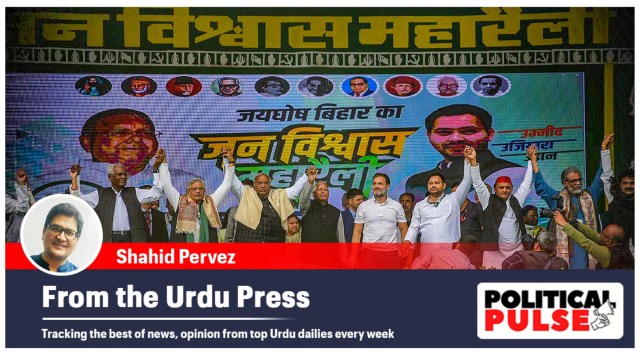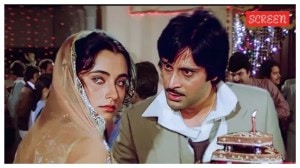From the Urdu Press: ‘What became of Modi guarantees on jobs, black money… Can Bihar show INDIA the way?’
‘Modi had made several big promises to the country for 2014 polls too. No one is ready to even question what happened to them. On top of that list was Modi’s pledge to provide 2 crore jobs to the people annually,’ writes Siasat
 Congress President Mallikarjun Kharge with party leader Rahul Gandhi, RJD chief Lalu Prasad Yadav, party leader Tejashwi Yadav, Samajwadi Party President Akhilesh Yadav and other opposition leaders during 'Jan Vishwas Rally', in Patna, Sunday, March 3, 2024. (PTI Photo)
Congress President Mallikarjun Kharge with party leader Rahul Gandhi, RJD chief Lalu Prasad Yadav, party leader Tejashwi Yadav, Samajwadi Party President Akhilesh Yadav and other opposition leaders during 'Jan Vishwas Rally', in Patna, Sunday, March 3, 2024. (PTI Photo)As the election season gets underway, key contenders have shifted to a higher gear with the BJP getting a head start by declaring 195 candidates, including Prime Minister Narendra Modi, the party’s mascot and campaign spearhead, who is eyeing a hat-trick. In contrast, the Opposition INDIA alliance still seems to be in the doldrums, struggling to stitch seat-sharing deals or a compelling narrative. Mapping the arc of the 2024 Lok Sabha elections, the Urdu dailies also tracked the Rajya Sabha polls, with the INDIA camp again losing the plot amid cross-voting and defections that even pushed the Congress government in Himachal to the brink.
SIASAT
Referring to the BJP’s move to release its first roster of candidates for the Lok Sabha polls, the Hyderabad-based Siasat in its March 3 editorial says that while the Election Commission has yet to announce the poll schedule, the ruling party has stepped up its preparations. On the other hand, the Congress and its other INDIA bloc partners continue to be stuck in their seat-sharing negotiations.
“The BJP has already mounted a massive campaign centred on its plank of Modi’s guarantees. All the party leaders have been pitching it, calling it indispensable for the country’s development. This is being amplified by pro-establishment media and channels round the clock,” the daily states.
However, the BJP camp does not appear to be keen to present its 10-year report card. “Modi had made several big promises to the country for the 2014 polls too. No one is ready to even question what happened to them. On top of that list was Modi’s pledge to provide 2 crore jobs to the people annually. His government has perhaps not been able to meet this target even in 10 years though,” the edit says. “The jobs in the government sector have been drastically pruned, with several public facilities and assets handed over to the corporates.”
Modi had also pledged to bring back Indians’ black money stashed overseas and credit Rs 15 lakh in the bank account of every citizen in the country, the paper notes, adding that the promise to double farmers’ income had also not been fulfilled. “The government is not ready to accept it and has even resorted to force against agitating farmers,” the edit says, asking “what is the guarantee that fresh poll guarantees will be fulfilled”.
SALAR
Commenting on the recent elections to 15 Rajya Sabha seats in Uttar Pradesh, Himachal Pradesh, and Karnataka — in which the BJP stunned the Congress by defeating its candidate Abhishek Singhvi in Himachal’s lone seat besides winning eight seats in UP by wresting an extra seat from the Samajwadi Party (SP) — the multi-edition Salar says in its February 29 editorial that these polls saw cross-voting, which was not a first. Besides the Congress and SP MLAs, even a few BJP MLAs did cross-voting in a trend which erodes public trust in democracy, it says.
In recent years, however, the culture of cross-voting has gained momentum, betraying cynical power politics and self-aggrandisement, the daily writes. “At the same time, the recent Upper House polls have also betrayed political mismanagement of some leading players. Its outcome throws up some key lessons, especially for the Congress and the SP,” the paper says. In UP, there was resentment among a section of the SP MLAs over the party’s nominees. “So, when the BJP fielded its eighth candidate, the SP should have doubled down on taking on board its disgruntled MLAs, which was not seen even as its chief whip himself ambushed the leadership.”
The Congress fared worse in Himachal, the daily notes. “This is the only state in the entire North India where the Congress is in power, having 40 MLAs in the 68-member Assembly. And yet the party’s candidate lost the Rajya Sabha poll as its leadership was out of depth, which is staring at a threat to the government now. Against this backdrop, what can the party expect in the state’s four seats in the Lok Sabha polls?” it asks.
The editorial notes that these polls again demonstrated the BJP’s will to power. This is the signal that the ruling party sought to send out to the voters ahead of the general elections, it states.
SIASAT on INDIA rally
Highlighting the INDIA alliance’s first joint rally, the Jan Vishwas Maha Rally held in Patna on Sunday, Siasat, in its March 5 leader, writes, “Sharing the dais with PM Modi now, Nitish is forced to repeat his line that he will not ditch the BJP again. Both the BJP and the JD(U) think that by joining hands they would again make a clean sweep in the state like they did in the 2019 Lok Sabha polls … However, the INDIA bloc’s Sunday rally at Patna’s historic Gandhi Maidan, involving the RJD, Congress, SP and Left parties, was a mammoth affair, with the entire city appearing to be charged with the energy and enthusiasm of its participants. It signalled a different public mood.”
The daily writes that Bihar has been a “revolutionary land” from where several mass movements started that changed the course of national politics. “The success of the Opposition grouping’s Patna rally may mark the beginning of a change in Bihar’s political scene, which needs to be followed closely in the countdown to the elections,” it says.
The editorial points out that the key leaders of the INDIA alliance who addressed the rally presented a show of strength, unity, and purpose. “However, various attempts have been mounted to create rifts between them. The Opposition camp must remain vigilant against such bids in coming days too,” it adds.
Photos





- 01
- 02
- 03
- 04
- 05


























